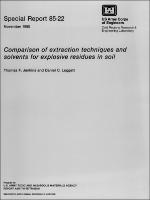Please use this identifier to cite or link to this item:
https://hdl.handle.net/11681/12196| Title: | Comparison of extraction techniques and solvents for explosive residues in soil |
| Authors: | U.S. Army Toxic and Hazardous Materials Agency Jenkins, Thomas F. Leggett, Daniel C. |
| Keywords: | Chemical analysis RDX Explosives Soil pollution HMX Soils Pollution TNT Explosive ordinance disposal Solvents |
| Publisher: | Cold Regions Research and Engineering Laboratory (U.S.) Engineer Research and Development Center (U.S.) |
| Series/Report no.: | Special report (Cold Regions Research and Engineering Laboratory (U.S.)) ; 85-22. |
| Description: | Special Report Abstract: Extraction of TNT, TNB, RDX and HMX from two soils was studied in terms of process kinetics and recovery. Two solvents, acetonitrile and methanol, and four extraction techniques, Soxhlet, ultrasonic bath, mechanical shaker and homogenizer-sonicator were compared. The results were complex in that some interactions among analyte, method and solvent were found. Acetonitrile was found to be clearly superior to methanol for RDX and HMX. Soxhlet and ultrasonic bath generally recovered more than homogenizer or shaker, although a complicating factor is that all techniques were not necessarily at equilibrium. In terms of sample throughput, the ultrasonic bath and shaker are preferred over Soxhlet and homogenizer-sonicator. The ultrasonic bath generally approached equilibrium more rapidly than the shaker so it appears to be the best overall choice. Another complicating factor is that times to reach equilibrium were different for the two soils and for the different analytes. This points to the need for more kinetic studies on other soils and sediments. |
| Rights: | Approved for public release; distribution is unlimited. |
| URI: | http://hdl.handle.net/11681/12196 |
| Appears in Collections: | Special Report |
Files in This Item:
| File | Description | Size | Format | |
|---|---|---|---|---|
| SR-85-22.pdf | 6.19 MB | Adobe PDF |  View/Open |